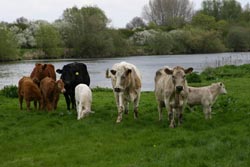Genetic marker test for mastitis
Mastitis, inflammation and or infection of the mammary gland, is a distressing disease, both for the cattle infected and for the farmer concerned. It has been estimated that 40% of the total herd in the United Kingdom can be affected in one year. The effects of mastitis are usually reduced milk yield and quality as well as extreme discomfort for the cow. Improvements in animal husbandry and hygiene can improve the situation but another means of control would be breeding for mastitis resistance. Accordingly, the EC project MASIITIS RESISTANCE has completed research on the fine mapping of the bovine genotype. This was in relation to the characterisation of quantitative trait loci (QTL) that affect masititis susceptibility in milking herds. The stretches of DNA that are associated with resistance to the disease have been studied in families within Finnish Ayrshire, SRB and Danish Red. These are breeds traditionally farmed in Nordic areas. Agricultural practices from these regions have a very strong tradition of recording data regarding the health and disease resistance of their herds. A team of scientists at the Danish Institute of Agricultural Sciences concentrated their resources on the development of a marker haplotype test for clinical mastitis. These tests involved the fine mapping of a small region of chromosome 9. This revealed a few alleles that can unambiguously identify all other required polymorphic sites in the region. This means that the test is certain to predict the presence of the single polymorphism in this region of the chromosome responsible for mastitis resistance. These results are available for use in commercial breeding programmes and a patent application for this exploitation has been sought. Together with the cooperative nature of the breeding initiatives in Nordic areas, they will no doubt be instrumental in the control of this economically important disease.



